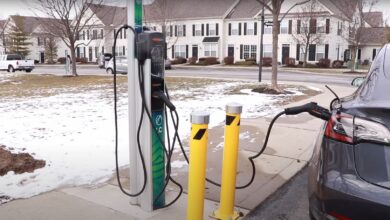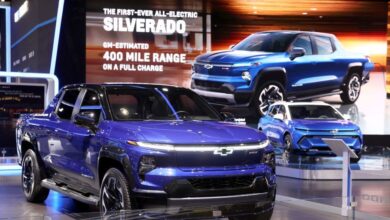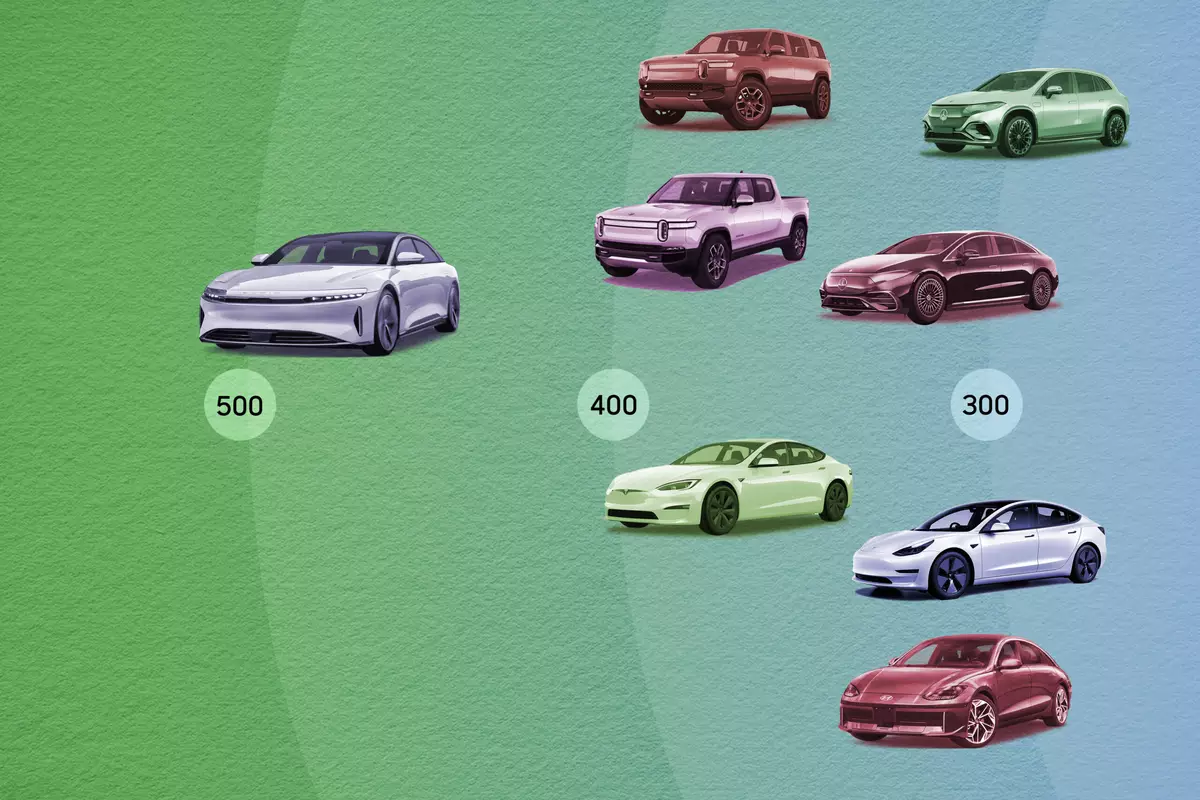The Ultimate Guide to Taking a Road Trip in an Electric Car

As someone who’s driven a 2001 Isuzu Trooper most of her life, getting the keys to an electric car made me feel like I was trading in a BlackBerry for an iPhone. With electric cars exploding in popularity, I traveled to sunny California last summer for a weeklong trip in Palm Springs, where I rented an Audi E-Tron Sportback and took it all the way to Joshua Tree National Park.
Because this was my first time getting behind the wheel of an electric vehicle, I wanted to make sure I was in an area with plenty of charging stations. To my surprise, I lasted the entire week without needing to use one. This was due to a combination of limiting myself to short drives and being able to charge up at my hotel — the Parker Palm Springs — but also because the car, like many EV models, has a median range of more than 250 miles.
All in all, there are many benefits to choosing this type of green transportation. Not only is opting for an EV great for the environment, but it even allows you to use the HOV lanes in certain states. Plus, you’ll save money by not having to buy fuel — basically a selling feature in itself these days. And don’t get me started on how useful it is to have two separate trunks (one in the back and the front, thanks to the lack of engine). So, ready to hit the road in an electric car? Here’s everything you need to know about road tripping in an EV, from determining the best time weather for driving to finding places to charge your electric car on the road.
Finding Charging Stations on the Road
As a first-time EV driver, I decided not to push the limits of the car’s range. However, it is possible to get your electric car across the country using public charging stations along the way. Electrify America, one of the largest networks of EV charging stations, is set up in many states and continues to expand. Download the Electrify America app, ChargePoint, or PlugShare to guide you to chargers all over the country. You can also find EV chargers on navigation apps like Google Maps and Waze.
Jason Zehr, a Chase Auto dealer commercial services underwriter, says shopping centers are great places to look for chargers, and some will even give you preferred parking spots. “You can have a meal and/or run errands while the car is charging, and some stores offer free charging to shoppers.”
Tesla owners Wes McLaughlin and Emily Martin, who road tripped in their EV from Virginia to Yellowstone and back for their honeymoon, said they had no problems finding places to top up their car battery. “We stayed near west Yellowstone in Idaho, and there was a charger just outside the park,” McLaughlin said. “We drove through snowstorms and buffalo herds without issues or worry that we wouldn’t be able to get to a charger.”
Driving in HOV Lanes in an EV
Certain states also allow EV drivers to use the HOV lanes, which allows you to save power and get to your destination faster. Check the rules of the states you’re traveling in on the U.S. Department of Energy website, which has an updated list of states with HOV exemptions. California, Florida, New Jersey, and New York are some of the states that allow EVs in the carpool lane. However, most states require registration, and you either get a decal or special license plate to show you’re permitted in the HOV lane.
Choosing Hotels With Charging Stations
When considering where to stay, opt for a hotel with a charging station. This way, you can park the car when you’re done for the day and power it up overnight. On the PlugShare map, you can filter results to show only charging stations with lodging. The results show lots of familiar chain hotels like Hiltons, Marriotts, Best Westerns, and Holiday Inns as well as plenty of independent properties. Some charging stations are free, while others require a fee. Keep in mind that, depending on the type of electric car you’re driving, you may need an adapter to plug in (for example, to plug a Tesla into a non-Tesla charging station).
Fortunately, I was able to charge my EV rental overnight at Parker Palm Springs, which fully juiced up the car battery for the following day. For more options across the country, travelers can also search for electric charging as an amenity when looking for hotels on search engines like Expedia.
Plugging in at Campgrounds
One of the best EV road trip hacks is that you can camp and use provided RV hookups to charge your vehicle. “If you rent a spot for an RV — typically $35 to $50 — you get a full charge and a good night’s rest for a decent price,” McLaughlin said. “We spent several nights camping in the car when we just needed a place to sleep before continuing on the next day.” The caveats: you’ll need to make sure the campsite you book has hookups, and you might need an adapter to plug in. The perks: in addition to giving you a place to park and charge for the night, it eliminates the need to pay for a hotel.
Knowing the Different Types of EV Charging Stations
Not all EV chargers are the same. There are three different tiers. Level 1 is the slowest (think a standard 120-volt plug). If your battery is nearing empty, a Level 1 charger could take up to 50 hours to power it all the way up. Level 2 is the most common and delivers a full charge from empty in anywhere from four to 10 hours. The cost of using these varies but is typically significantly cheaper than paying for gas. Level 3, also known as Direct Current Fast Chargers, is the quickest option, getting you back on the road with a near-full battery in as little as 20 minutes. Again, the cost can vary. Some Tesla Supercharger locations offer on-peak and off-peak rates.
Conserving Your EV Battery on a Road Trip
Because of their regenerative braking systems, EVs are generally more efficient in stop-and-go traffic than they are on the highway. So, to conserve your battery, opt for city roads that require low speeds and lots of braking. This is counterintuitive to any driver who’s used to traditional fuel-powered cars, which are more efficient at consistent speeds.
Additionally, you can conserve your EV battery by keeping the AC or heat off, or switching them to eco-mode, and avoiding hard acceleration. Note that batteries drain faster in extreme temperatures.
Planning Your Road Trip in Ideal Weather
Warm-weather road trips are the way to go when driving an electric car. Like your phone, EVs lose power quicker in cold weather, so if you’re hitting the open road in the winter, you’re going to have to charge your car more often. “We drove in 17 degrees Fahrenheit and lost battery fast,” Martin said.
Likewise, really hot temperatures can cause the battery to work harder — especially if you have the AC cranked up — and potentially overheat. In these kinds of extreme temperatures, the chemical reactions that make the battery function occur more rapidly, which makes it less efficient.
Renting an Electric Vehicle
If you don’t own an electric car — and aren’t quite ready to commit to buying one — a road trip is the perfect way to test the waters. Rental companies like Turo, Sixt, Hertz, and Enterprise all have their own EV fleets available for rent. Before taking your rented EV for a long-distance spin, make sure you know its driving range, download apps to help you find charging stations, and maybe even read up on the model on the dealer website so you know exactly what it needs and how to operate it. EVs might cost a little more than your cheapest fuel-powered economy option, but not having to buy gas could make up for it in the long run.
Handling Car Troubles When Road Tripping in an EV
Beyond not having to waste money on gas, EV drivers also save on maintenance. “I don’t miss oil changes or replacing alternators and belts,” McLaughlin said. “As someone who has never been a ‘car guy,’ it’s nice to know that I can actually do all the maintenance on my car by myself, which is just adding windshield washer fluid.” When you’re venturing out on long distances, it’s reassuring to drive something that has a lower chance of breaking down. Running out of battery with no way to charge is one of the worst things that can happen, but some dealers like Audi will get you out of the situation with complimentary towing. Of course, it doesn’t hurt to carry AAA.



